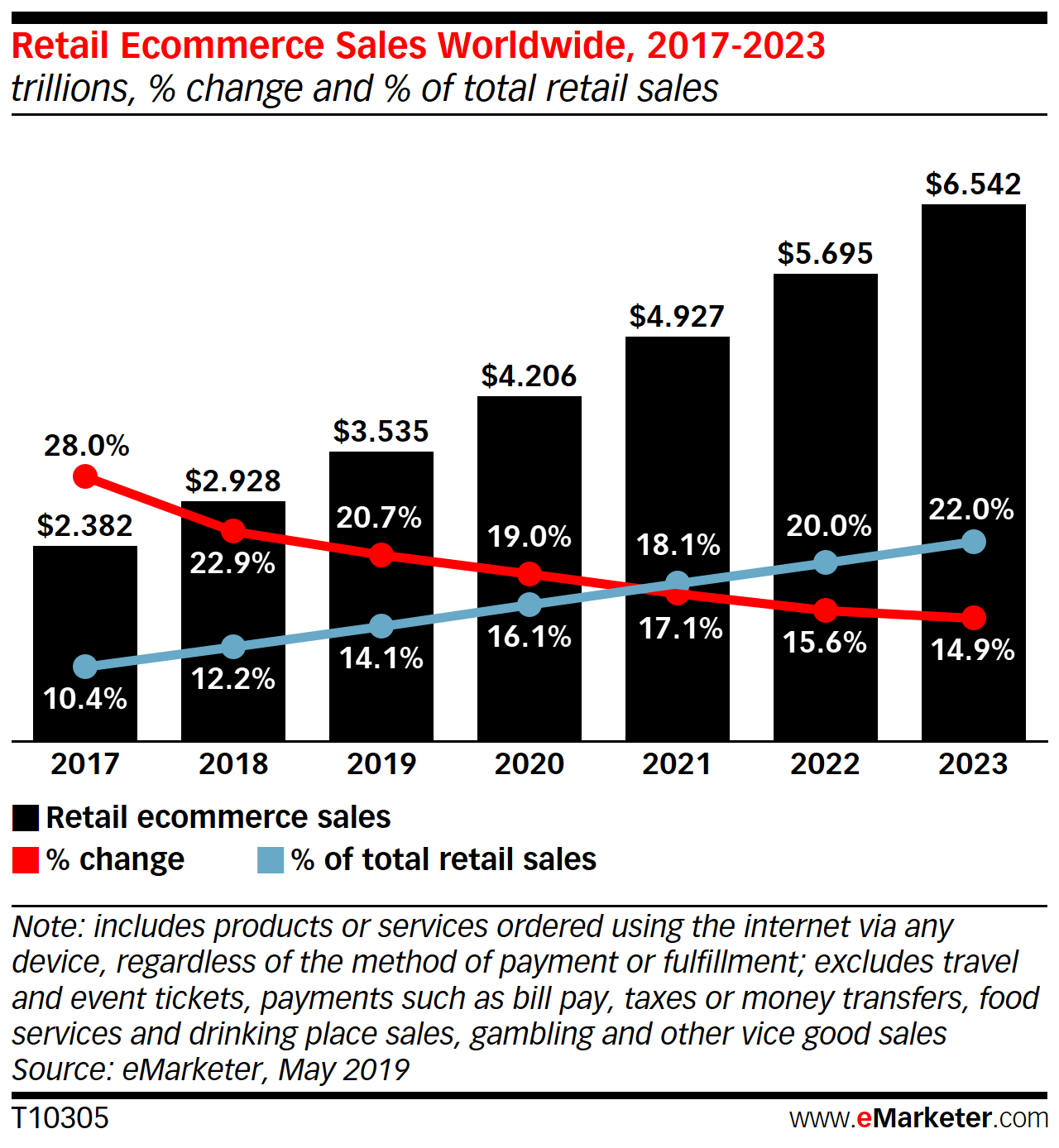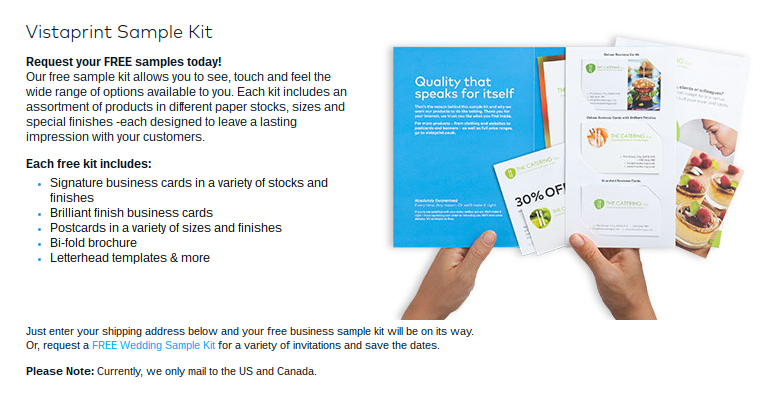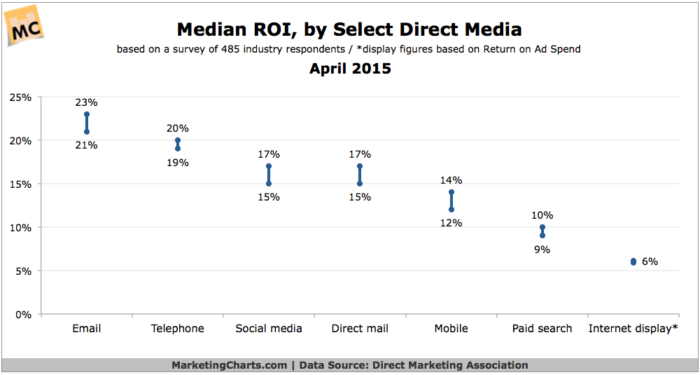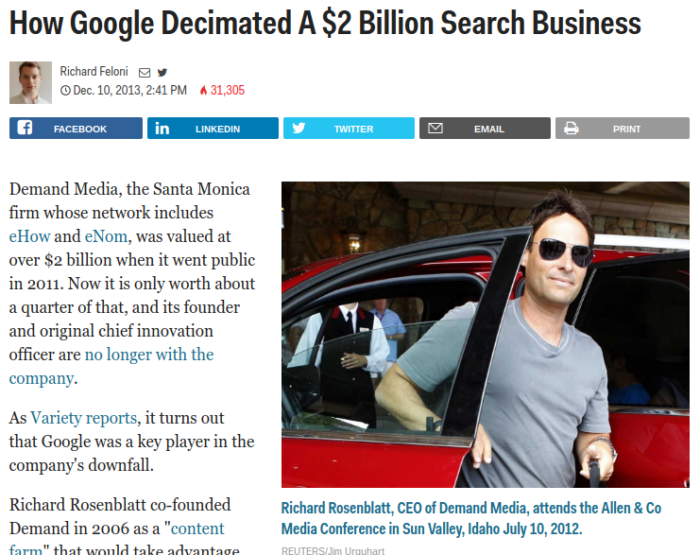The Future of Ecommerce Marketing: Insights from Entrepreneurs, Executives, and Influencers
Deep DiveTable of Contents
- Vistaprint: expansion plans for a $3.11B empire
- Wayfair: how to maintain 12.6 million monthly organic visits
- Warby Parker: scaling $100 million in sales
- Shopify: winning big as a small business
- Spearmint LOVE: $5 cost of customer acquisition and 5-10x ROI
- BigCommerce: faith in tried-and-true ecommerce marketing tactics
- Wrap up
In 2016, eMarketer estimated worldwide ecommerce sales had reached $1.915 trillion. By 2020, the market research firm predicts that figure will rise to $4.058 trillion—more than doubling in size in four years. That means there’s enormous opportunity for ecommerce brands to grow and thrive.

However, online stores do operate in an increasingly competitive and demanding environment. Back in 2014, ecommerce expert Omer Rachamim believed there were between 12 and 24 million online stores around the globe. Surely, that number has grown too.
And, as the years go by, the ecommerce landscape and the industries surrounding it evolve, along with consumer behaviors and preferences. Here are a few examples:
- Two-day shipping, popularized by Amazon, has become a norm.
- On-demand services such as Drizly, Instacart, and Uber have, in many ways, spoiled users.
- Subscription boxes, courtesy of ButcherBox, Frank + Oak, and Loot Crate make shopping effortless.
- Ranking for targeted search terms on Google is no longer as simple as buying links and stuffing keywords.
- Social media is now a leading driver of traffic for ecommerce sites around the web.
- Display advertising has changed, too. Now brands have to be even savvier about how they promote their businesses to capture and maintain market share.
To understand how successful ecommerce businesses are adapting in today’s fluid market, we spoke with ecommerce entrepreneurs, marketers, and writers to get their perspective.
Vistaprint: expansion plans for a $3.11B empire
As of January 25th, 2017, Cimpress, Vistaprint’s parent company, had a market capitalization of $3.11 billion. And in 2016, according to Sara Nash, public relations manager of Vistaprint’s North America operations, the printed marketing materials company turned over $1.2 billion in sales. Still, the business has its sights set on further growth.
To fuel those ambitions, Vistaprint’s marketing team employs a variety of different marketing strategies. And two important approaches it’ll continue to use in 2017 are:
- Direct response marketing
- Print catalogs and sample kits
Vistaprint’s expansion of direct response marketing
Cindy Starr, senior vice president of marketing at Vistaprint, says, “Direct response marketing is still our bread and butter, but we have significantly evolved it over the last few years and will continue to do so. We now incorporate higher level messages that showcase the breadth of our products, and the value we provide business owners beyond price. We have implemented this approach across the board, from email to social media to broadcast.”
An analog strategy for a digital brand

Among most ecommerce brands, marketing strategies are always designed to be digital-first. In many cases, analog tactics are out of the question. However, one under-utilized yet highly effective promotional approach is direct mail. “We’ve also seen great success with our print catalogs and our sample kits, which we’ve started using in the last few years,” says Starr. “They provide a great opportunity to show our customers that we sell quality products beyond just business cards, and we expect to continue our investment in this area.”
Comparable case studies and research
In an article for Harvard Business Review, Craig Elbert, vice president of marketing at Bonobos, discloses that “20% of the website’s first-time customers are placing their orders after having received a catalog and are spending one and a half times as much as new shoppers who didn’t receive a catalog first.”

Research published by the Direct Marketing Association (DMA) in 2015 also reveals the following media ROI for select direct media campaigns:
- 23-21% for email
- 20-19% for telephone
- 17-15% for social media
- 17-15% for direct mail
- 14-12% for mobile
- 10-9% for paid search
- 6% for Internet display ads
Bottom line: for ecommerce brands of all sizes, as long as your marketing initiatives produce positive ROI, you can afford to continue investing in it. However, you’ll want to prioritize campaigns that generate the most ROI.
Want to improve your marketing skills? Here are a few must-read resources:
For direct-response marketing:
- 4 Keys to Direct Response Marketing Entrepreneur
- Best Practices For Online Direct-Response Marketing Fast Company
- Effective Direct Response Marketing: One-Shot vs. Campaign MarketingProfs
For print catalogs and direct mail:
- The Revival Of Print Catalogs In Ecommerce Marketing ReferralCandy
- Why Catalogues Survive in a Digital Age Business of Fashion
Wayfair: how to maintain 12.6 million monthly organic visits
Data from SimilarWeb estimates Wayfair.com, the $3.66 billion home goods giant, generated 37.4 million visits in December 2016. Of all those visits, 33.74% supposedly came from organic search. That’s roughly 12.6 million monthly organic visits. However, to build and maintain such a massive SEO program is no small feat.

Four important philosophies to Wayfair’s SEO strategy are:
- Ranking first for your targeted keywords
- Investing in domain-wide and page-specific SEO improvements
- Strictly applying white-hat tactics
- A mobile-first approach
The importance of ranking first
Back in 2015, Wayfair’s SEO manager Alex Stein made a major discovery most SEO professionals hadn’t thought much about before. He found evidence suggesting that not all organic search traffic is equal. When a sudden Google algorithm change boosted Wayfair’s rankings, he realized that traffic from keywords Wayfair ranked first for converted much better than visits from keywords with less dominant rankings.
Stein explains,
“We made the assumption that the incremental organic visits came from our new #1 rankings and saw that those visitors were 160 percent more likely to convert to purchase. This makes sense—users who are clicking on the first result in search are likely closer to purchase, while users who are bouncing around the first and second pages are price comparing and in the consideration phase of their shopping.”
How to build lasting domain authority
However, unlike many businesses that tend to take their #1 keyword rankings for granted as soon as they earn them, Wayfair invests additional resources into maintaining its coveted first position.
When asked about how Wayfair protects its rankings, Brian Wood, director of marketing and SEO, shares, “The first step is to always be monitoring all rankings, even the #1 rankings, and to constantly work on strategies that will benefit the entire site as well as the individual pages you’re targeting.” To do this well, though, Wayfair deploys human capital to outperform the competition. Wood adds, “The best way to gain big is by investing in people and tools to do the kind of SEO work that isn’t automated; it’s the tactics that aren’t easily replicated that give us the opportunity to excel.”
Why white-hat tactics matter
For some, ranking well on Google’s search engine results pages (SERPs) is like trying to hit a moving target. With each algorithm change, marketers brace themselves hoping the omnipresent search engine has not, at practically the push of a button, undone all of their hard work. SEO penalties have destroyed many businesses in the past; the sudden demise of Demand Media is one harrowing example: at its peak, the company was worth $2 billion but has since lost more than 90% of its value. As of January 25th, 2017, Demand Media’s market cap is about $140 million.

Fortunately, SEO professionals who play by the rules are mostly likely to benefit with each Google search algorithm update. Wood believes, “What’s against the rules hasn’t changed much in the last decade—instead, Google has just gotten better at catching sites that are breaking the rules. So sites that follow white-hat tactics tend to be safe, even as Google’s spam algorithms improve.”
Recommended resources to become a better SEO:
A default to mobile search
When CIO.com interviewed Wood in 2014, he believed mobile was the future of search. And he was right. Now Wood knows, “Mobile has become, and will continue to be, increasingly important. At the end of 2016, Google announced that they will be switching their entire algorithm to run off of mobile sites, rather than desktop, as it has for the past 20 years.” For ecommerce store owners and marketers, what’s important to note is: “This is a fundamental paradigm shift for the SEO industry. SEO teams need to adjust their strategies to be mobile-first to stay relevant.”
For ecommerce companies, mobile SEO should be a priority, especially now that customers are increasingly completing purchases through their mobile devices.
- Measure and optimize your page load times
- Employ responsive web design
Warby Parker: scaling $100 million in sales
When Warby Parker raised $100 million in funding in 2015, bullish venture capitalists valued the eyewear company at $1.2 billion. Estimates suggest the company generated $100 million in sales that year too. As it prepares for what some speculate to be a 2017 IPO, three ways the business will continue to promote itself are through:
- Video marketing
- Channel diversification
- Investments in the pre- and post-purchase experience
Incorporating video
Consumers are increasingly spoiled. High-speed Internet and LTE networks have made it possible to view HD video anywhere at any time, and audiences now crave well-produced visual content. Feeding into customer preferences, the team behind Warby Parker plans to invest big into video in 2017.

“As a marketing team, we are really excited by how fast the media landscape is changing and evolving. We have found that with change comes massive opportunities,” says Brian Magida, director of digital marketing at Warby Parker. “In 2017 we are thinking a lot about video. How can we incorporate more video to drive awareness, consideration, and ultimately purchases? We’ve begun to experiment with including more videos on the website to enhance our product launches. The most recent examples being our Spring 2017 collection and our collaboration with Tyler Oakley.”
Recommended video marketing resources:
- 17 Best Ecommerce Product Video Examples BigCommerce
- How To Make A Great Marketing Video For Your Company In Minutes Forbes
Diversifying marketing interests
At scale, ecommerce companies would be wise to diversify their marketing strategy, both in an effort to limit their dependence on any one or two particular channels as well as to explore opportunities that can further accelerate growth.
“Over the years we have been able to scale a number of different core digital marketing channels,” tells Magida. “As with many ecommerce and fashion brands, we’ve seen a lot of success on Facebook/Instagram and Google. We’ve also found success on newer networks such as Pinterest, who are able to deliver a unique audience through their differentiated targeting options.”
Beyond social media, Magida shares, “We will continue to invest in Podcasts, a channel we have been actively investing in since 2012. We do our best to not be too overweight any one tactic or channel.”
Need more traffic to your online store?
Obsessing about the product and customer experience
To position a business for long-term success, its product(s) should be superb. “Having a great product is step number one,” believes Magida. “Oftentimes the ‘product’ is viewed as just the widget, but it really is much more than that. At Warby Parker, we view the product as the overall experience. From the first time you hear about the brand, to the phone call you have with an advisor, to the package you receive in the mail—all of those elements are part of our product. We are obsessed about that version of the product from day one and continue to be today. We want to deliver remarkable experiences to our customers. When you deliver remarkable experiences, your marketing will work exponentially better.”
An investment in your product and customer experience can amplify the effect that your marketing may have among consumers.
Shopify: winning big as a small business
According to Shopify’s Q3 2016 results, the Ecommerce platform is home to 325,000 merchants across 150 countries.

As a marketer at Shopify, Corey Ferreira is a champion and role model for aspiring store owners. In fact, Ferreira is an ecommerce entrepreneur himself, who owns and operates a six-figure dropshipping business. His experiences have led him to conclude that there are two important things upstart ecommerce businesses owners and marketers should know to facilitate success:
- Emulate winning strategies
- Exhaust every opportunity to profit
Emulate winning strategies.
When you ask Ferreira to predict which trends ecommerce stores should adopt next, he responds: Ask the competition.
“Maybe some people will consider my opinion as always being one step behind but I really like to keep a close eye on competitors,” admits Ferreira. “If my competition is moving to Snapchat, maybe it’s time for my business to experiment. My competitors are using FB Live regularly now? Maybe I should test it. There’s a lot to be said about being an early adopter and first to ride a wave but it’s also very risky. If you’re a solopreneur or have a smaller team, you might want to use a strategy like this. Let the bigger competitors with bigger budgets and resources take risks, and innovate/improve on their mistakes.”
Indeed, for resource-limited businesses, this is a brilliant approach. “It takes a lot of effort and resources to try to stay ahead of the innovation curve, especially as a small business. I’d much rather focus on a few proven channels/strategies than constantly trying to shift focus while trying to catch the next trend,” says Ferreira.
Recommended tools for spying on the competition:
Exhaust every profitable opportunity.
“A new development in ecommerce marketing ending up as a fad isn’t necessarily a bad thing,” suggests Ferreira. “A lot of things in business and marketing are temporary. It doesn’t necessarily mean that a business owner should never execute on them. Banner ads are no longer as effective as they once were, but when they worked, you’d be insane not to have a paid ad strategy. The same is true for a lot of ecommerce marketing strategies. If you know you can acquire a customer for an amount that is profitable on a channel that may or may not be a fad, you should still pursue it. Digital marketing is so modular now a days, it’s very easy to make a switch when necessary.”
While many business experts may recommend investing heavily in identifying and scaling sustainable marketing channels, one big determining factor of your long-term success is your ability to gather enough short-term capital or sales to finance ongoing operations. Frankly, some stores simply cannot afford to forgo opportunities to make some quick and reliable cash.
“Personally, I love retargeting and it has worked really well for me. Even if you had a crystal ball and told me retargeting was going to stop working next week, I would still be doing it until the last day because it is profitable for me and my business. And, as one ecommerce marketing tactic dies off, another one will emerge for me to test on my business,” shares Ferreira.
Spearmint LOVE: $5 cost of customer acquisition and 5-10x ROI
When Shari Lott first launched Spearmint LOVE, her goal was to simply get a product, sell it, reinvest the profits, and then start the cycle all over again by selling more products. As her business grew, Shari Lott and her husband John Lott, former CFO and COO of startup Quirky, decided it was time to pilot a paid advertising program to see if they could use Facebook Ads to further grow their business.
And what they discovered was Spearmint LOVE’s key metric for success:
- An aggressively low cost of customer acquisition (CAC)
Testing Facebook ads
For the first three years, the couple spent $0 in advertising; Instagram was their go-to promotional platform. They’ve amassed an enviable 544,000 followers. But, finally, they wanted to see how paid ads could work for Spearmint LOVE and, in March 2016, they gambled their first marketing dollar.

When the year was over, the Lotts had spent a total of $176,000 on Facebook ads. Best of all. they’d figured out a way to lower their average CAC to $7.5, according to their advertising dashboard on Facebook. But John Lott insists that figure is inaccurate. At scale, Spearmint LOVE’s CAC is “well below” $5 because of the organic attention the brand receives when a customer acquired through paid Facebook ads refers a friend and helps to convert an additional sale.
But that’s not all. The Lotts also aim to generate an ROI of 5-10x on their Facebook ads. In an interview with BigCommerce, John Lott says, “For us, we’re looking at ad spends where we’re getting at least $5 of revenue or more, preferably closer to the $10 mark for every dollar of ads spent.”
Recommended resources to propel your Facebook Ads strategy:
Investing in paid search and Pinterest, too
According to John Lott, the four customer acquisition channels Spearmint LOVE pays attention to are:
- Facebook and Instagram, which drive approximately 94% of total sales
- Google (organic and paid), which contributes 4-5% of total sales
- Bing (organic and paid), which helps generate 1% of total sales
- Pinterest, which drives a ton of traffic to the Spearmint LOVE site but has an attribution problem, thus driving <1% of total sales.
Bing has some of the most competitive advertising economics, according to John Lott. With a CAC of $5 on Facebook, that seems like an outrageous claim. However,

In the new year, the Lotts plan to invest more in their Pinterest strategy. To-date, they have managed to grow their Pinterest page to 12,000 followers while spending what they claim to be “zero” time on it. Skeptical, I inquire how that could be, and Shari Lott answers, “We cross-post our content from Instagram to Pinterest automatically” without ever actually having to open Pinterest again. Their weapon of choice? IFTTT.
Recommended tools for seamless social sharing:
BigCommerce: faith in tried-and-true ecommerce marketing tactics
With technology rapidly changing the marketing and media landscapes due to the introduction of branded content, Facebook Live, virtual reality, and more, it’s easy to lose sight of tried-and-true ecommerce marketing tactics that have real staying power. Tracey Wallace, editor in chief of the BigCommerce blog, believes the key to capturing and engaging customers is twofold:
- Retargeting
- Email marketing
Retargeting past audiences
As technology evolves, “Retargeting is only going to get better and better,” believes Wallace. “People have been talking about personalization forever it seems, but 2017 is the year it becomes a reality. With platforms like Get Smart Content and tools like BigCommerce offering Customer Group capabilities (i.e., showing customers in a group a different site experience), brands will be able to target messages and products to particular cohorts. In other words, you’ll never show a discounted product to a customer who almost always buys full price again. And you’ll get much more targeted on the type of discounts you do offer to those discount-only purchasers. All of this means increased sales with higher margins.”
And the business case for investing in retargeting is simple. For Search Engine Land, digital marketer Dax Hamman writes, “The easiest sell is ROI—clients will often achieve a return of $2 to $10 for every $1 they invest into search retargeting, that’s hard to ignore!”
Abandoned cart emails and digital receipts

The average marketing email generates $38 in ROI for every dollar spent, according to data from the DMA.
And Wallace knows, “In terms of email, abandoned cart emails and receipt emails reign (though nurture streams are still vitally important!). Abandoned cart emails can bring back about 15% of what would have been lost sales. It’s also a great opportunity to upsell or drive loyalty through content.”
Wrap up
Although technology and the mediums which we, as ecommerce brands, entrepreneurs, and marketers, use to engage consumers will change, what should remain constant is our resolve to create and communicate value to our customers.
While it’s uncertain how the ecommerce industry and marketing and media landscapes will evolve in the coming years, one thing is clear: Marketing is a vital component to long-term growth and success. And, to thrive in 2017, you’ll want to invest your marketing dollars carefully into campaigns that produce positive ROI or into the customer experience to amplify the impact of all your marketing efforts.